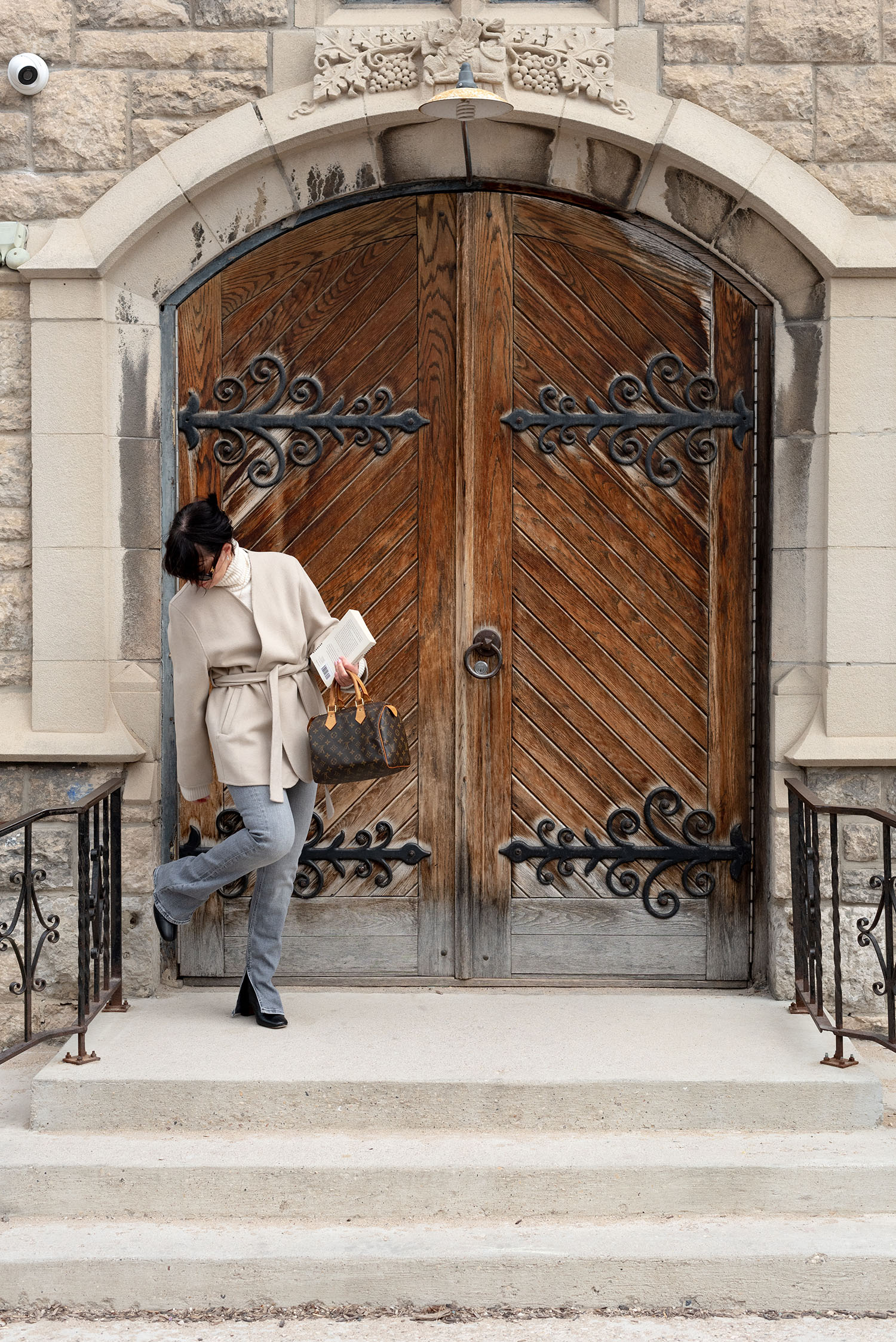
Zara sweater (similar)
Mavi jeans (c/o)
Rouje boots (similar)
Celine sunglasses
Louis Vuitton handbag
Stella & Dot ring (similar)
Mejuri earrings (c/o) (similar)
Location: Saint Luke’s Church – Winnipeg, Manitoba
Book: Jane Eyre – Charlotte Bronte
Jane Eyre sat on a bookshelf in my parents’ dining room from the time I was born. Its presence in the house predated mine. I knew the look of the spine of each book, and where it fit on the shelf, but in childhood I was conscious of little more than the titles and colours. The books on those shelves were decorative, to me, fixtures of the scenes of my life much like vases and picture frames. I was seven when I attempted to read a novel on my own for the first time. It was a book from the Boxcar Children series, bought from a Scholastic book order rather than pulled from the veritable library in my parents home. To be honest, it wouldn’t occur to me to start taking advantage of that until years later.
What I’m getting at is that Jane Eyre became a book that I loved very early in my life, but it wasn’t a book that I chose. I read voraciously on my own, took stacks and stacks of books out of the local library on every visit. But that wasn’t all – and frankly, it wouldn’t have been enough. Every night before bed, Mom and I read together. We worked our way through essential girlhood classics, including the entire Little House on the Prairie series and all of Anne of Green Gables. (I preferred the pragmatic, realistic Laura to whimsical orphan Anne, to whom everything always seemed to come a bit too easily.) Somewhere in between, probably when I was eight, we read Jane Eyre.
I would have been about the same age as Jane is at the start of the novel when we read the first chapters. And like anyone with a shred of empathy, I was appalled by the circumstances of Jane’s childhood. The situation turns from bad to abhorrent in a matter of pages. Once it reaches abhorrent, it takes years before Jane gets anything even remotely resembling a reprieve. And that reprieve is only ever temporary. Another tragedy, somehow worse than the last because it is unexpected, always quickly follows.
My own childhood was a safe, sheltered one. Meals arrived on time and were always prepared according to our (sometimes very specific) tastes. (Seriously. There was an entire series of years when I refused to anything for lunch but cereal. My parents not only tolerated that but bought a variety of different cereals so I never got bored.) We had warm clothes, soft beds and very little exposure to hardship. It was mostly through literature that I developed an understanding that this existence was a rarefied one and that, although everything wasn’t always perfect, I was lucky.
It was Jane Eyre, in particular, that drove that point home for me. I was a good girl, an inveterate rule follower and people pleaser. And so in theory, I could have argued that I deserved my charmed life because I did everything right. But characters like Jane stopped me from doing that, because they illustrated with such devastating clarity that too often, it doesn’t matter if you do everything right – awful things still happen and after you live through them, you have to live with them. And it’s the way you live with them, what you do with what’s been done to you, as Sartre says, that is what matters.
Before suffragists, before feminism and before the Girl Power movement that would start when I was a pre-teen, there was Jane Eyre. Proof, in writing, that a woman, no matter how young or poor, not only could or should but owed it to herself to be her own protector, and would always be capable of it if she were willing to take the risk. It’s been nearly two hundred years since her namesake novel was published and her statements about self-love and self-worth still sound courageous. My eight-year-old self couldn’t resist cheering for her when she politely defied her alleged superiors. I hoped, someday, I’d be confident enough to be like her.
Jane is the original independent woman. She dares to speak up for herself, to defy conventions that don’t suit her. She is proof that the road less traveled, while sometimes lonely, is almost always the most fulfilling one to take. I reread her story often, and I remain in awe of her sheer stubbornness in the face of obstacles. The real world doesn’t bend to our will the way the literary one sometimes does for her, but watching her fight for, and eventually win, the life she wants is stirring nonetheless. I don’t know why Mom chose Jane Eyre, when we might have read anything by Jane Austen, or anything else on the dining room shelves, instead. But I’m glad she did. I remain convinced that Jane is the literary heroine every little girl needs and deserves.
She was, and will always be, my favourite.
I didn’t always have the courage of conviction to follow in her footsteps, but I wanted to. At fourteen, I beat myself up constantly for my seeming inability to exercise my right of refusal. Jane taught me that I could say no. For any reason at all, or without giving one. It’s because of her that I knew there would always be another way. I just needed to be brave enough to take it.